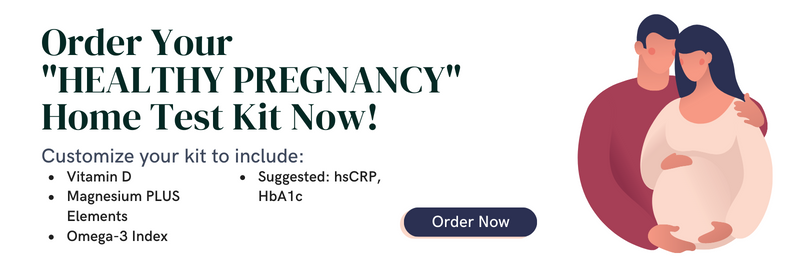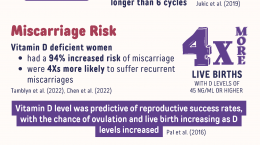Published on August 19, 2022
VIDEO FRIDAY: “Researchers have found that pregnant women with low levels of omega-3s are at most risk” for going into early labor, prompting changes in standard prenatal screening
Key Points
- The Hospital Research Foundation in Australia is delegating $500,000 to add omega-3 testing to standard first-trimester screening for pregnant women
- One study on pregnant women found that a higher intake of EPA and DHA resulted in an approximate decrease of 70% for early preterm birth, 85% for very low birth weight, and 60% for low birth weight
- Getting vitamin D levels to at least 40 ng/ml during pregnancy may have an even greater impact on preterm birth rates, with one study showing a 62% lower risk of preterm birth for women with vitamin D levels at or above 40 ng/ml (100 nmol/L) compared to women with levels less than 20 ng/ml
 Last year, the Australian Government officially added omega-3 fatty acid supplementation to their list of recommendations for pregnant women, with a warning issued that low omega-3 levels could increase the chance of preterm birth. The Hospital Research Foundation in Australia is now delegating $500,000 to add omega-3 testing to standard first-trimester screening for pregnant women.
Last year, the Australian Government officially added omega-3 fatty acid supplementation to their list of recommendations for pregnant women, with a warning issued that low omega-3 levels could increase the chance of preterm birth. The Hospital Research Foundation in Australia is now delegating $500,000 to add omega-3 testing to standard first-trimester screening for pregnant women.
Watch the short video clip and read the details below on how “HUGE GAINS” could be made, relatively easily, by eliminating BOTH low omega-3 levels and low vitamin D levels in pregnancy! While you may not live in Australia, you can still take advantage of this information for yourself to ensure healthy omega-3 (and vitamin D) levels before and during pregnancy by measuring your levels at home.
Watch the Video
Omega-3 Fatty Acids Benefit Both Mom and Baby, Even After Birth
Several studies demonstrate the importance of omega-3s for pregnancy, such as a study by Carlson et al., in which a higher intake of EPA and DHA resulted in an approximate decrease of 70% for early preterm birth, 85% for very low birth weight, and 60% for low birth weight. When combining data from 9 different randomized controlled trials on omega-3 supplementation and preterm birth, Kar et al. found that omega-3 intake was associated with a 58% reduced risk of early preterm delivery, while a 17% decreased risk of any preterm birth was seen among women who supplemented with omega-3s.
Other studies have shown a relationship between omega-3 intake or status during pregnancy and outcomes such as infant immunity, time of gestation or preterm birth, birth weight, and even the incidence of postpartum depression. In fact, Markhus et al. showed that a higher Omega-3 Index at the end of pregnancy greatly reduced the risk of postpartum depression.
Omega-3s promote brain health during pregnancy and early life, and infants need omega-3s, especially DHA! A study by Tai et al has linked the intake of DHA during infancy to improved eye sight for child, higher IQ, better communication and social skills, less behavioral problems, and a decreased risk of developmental delay, ADHD, autism and cerebral palsy.
Getting Prenatal Vitamin D Levels to 40 ng/ml May Have an Even Greater Impact on Preterm Births
Several studies have shown that achieving a vitamin D level of 40 ng/ml (100 nmol/L) during pregnancy is related to decreased risk of preterm birth and other complications in pregnancy and early childhood. Results from a published GrassrootsHealth study showed a 62% lower risk of preterm birth for women with vitamin D levels at or above 40 ng/ml (100 nmol/L) compared to women with levels less than 20 ng/ml.
These findings were based on a project implemented in 2015 by GrassrootsHealth and the Medical University of South Carolina (MUSC) to initiate a new standard of care to screen all pregnant women at their hospitals for vitamin D levels with the goal of getting their vitamin D levels to at least 40 ng/ml.
Black women have a 15-20 fold higher prevalence of severe vitamin D deficiency, putting them at much higher risk for preterm birth. According to NHANES data, approximately 68% of Black women have vitamin D levels below 20 ng/ml (50 nmol/L) and at these levels, would be expected to have a 20% preterm birth rate; this is a problem that must be addressed especially for mothers within these groups of darker skin! Research has shown that the gap in preterm birth outcomes between White and Black mothers virtually disappears when vitamin D deficiency is corrected.
Other Health Effects of Vitamin D for Pregnancy & Baby
Vitamin D levels in the range of 40-60 ng/ml (100-150 nmol/L) have been shown to reduce additional prenatal complications, including hypertensive disorders of pregnancy (preeclampsia) and gestational diabetes. The Pregnancy Disease Risk Reduction Chart provides an illustration of some of the findings from studies that have compared prenatal and newborn health outcomes to vitamin D levels. It shows the percent lower risk at a given vitamin D level compared to a common reference level of 25 ng/ml (62 nmol/L), which is the approximate average level of the U.S. population.
Healthy vitamin D levels are also necessary for healthy conception. Studies have found that vitamin D deficiency can increase risk of miscarriage by 94% and increase risk of recurrent miscarriage 4 times, with vitamin D deficiency among male partners also contributing to a higher risk.
Why You Can’t Assume Your Omega-3 or Vitamin D Supplement is Enough
When supplementing with either vitamin D or omega-3s, it is impossible to know how much of a dose might be “right” for one person to the next.
Vitamin D Supplement Dose: Everyone responds differently to vitamin D… by up to 6 times for the same supplement amount! For example, it is possible for a supplemental intake of 4000 IU/day to result in a serum level of 25 ng/ml (62.5 nmol/L) in one individual, and 60 ng/ml (150 nmol/L) in another. A GrassrootsHealth analysis showed that among all adult participants taking an average of 4,000 IU vitamin D per day from supplements, approximately 25% were still below the recommended 40-60 ng/ml.
Omega-3 Supplement Dose: Just as with vitamin D, there is a large amount of variability in the omega-3 status for different people with the same intake amount. For example, our initial analysis showed that the range of response with 1000 mg of EPA+DHA per day was 5.7% to 10.2%. This large amount of variability is similar to what we have observed for vitamin D.
Getting Enough Magnesium and Avoiding Toxic Elements are Also Important for a Healthy Pregnancy
Magnesium is also important to a healthy pregnancy, and getting enough magnesium has been shown to help ameliorate muscle cramping during pregnancy, decrease the frequency of preterm births, low birth weight and small for gestational age newborns, and used as a treatment for preeclampsia/eclampsia. Magnesium in pregnancy has also been associated with metabolic syndrome for the child later in life.
During pregnancy, toxic elements such as lead stored in bones can be released and passed from the mother’s body to the baby which may result in miscarriage, premature birth, low birth weight, learning or behavioral problems, or damage to the baby’s brain, kidneys, or nervous system. Cadmium is another toxic element that can also accumulate in the kidneys and thyroid gland, and can contribute to thyroid issues, kidney disease, infertility, uterine fibroids, and other reproductive tract diseases if the build-up is high enough.
Measure Your Levels of the Above for a Healthier Pregnancy and Baby
Based on the information presented above, measuring your levels of vitamin D, magnesium, and omega-3s may help determine if more of these nutrients might be needed to support a healthy pregnancy and baby. Create your custom home blood spot kit with the following measurements to help determine if you are getting enough of the following nutrients shown to benefit your current or future prenatal health:
- Vitamin D
- Omega-3 Index
- Magnesium PLUS Elements
- Add hsCRP as a marker of inflammation and HbA1c as a marker of blood sugar health, two other important factors influencing prenatal conditions
Don’t forget several other essential nutrients for reproductive health, including the below and many more
- B Vitamins (especially Folate)
- Iron
- Zinc
Having and maintaining healthy vitamin D levels and other nutrient levels can help improve your health and the health of your baby, now and for the future. Enroll and test your levels today, learn what steps to take to improve your status of vitamin D (see below) and other nutrients and blood markers, and take action! By enrolling in the GrassrootsHealth projects, you are not only contributing valuable information to everyone, you are also gaining knowledge about how you could improve your own health through measuring and tracking your nutrient status, and educating yourself on how to improve it.







